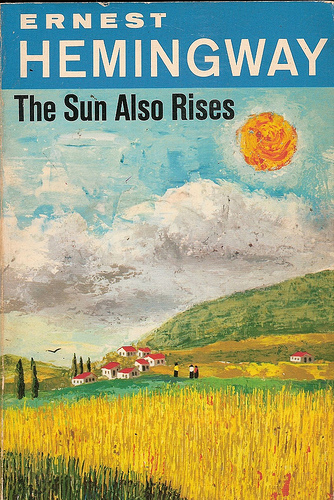 |
Cover painting by James & Ruth McCrea (1974) |
"The Sun Also Rises portrays the lives of the members of the so-called Lost Generation, the group of men and women whose early adulthood was consumed by World War I. This horrific conflict, referred to as the Great War, set new standards for death and -immorality in war. It shattered many people’s beliefs in traditional values of love, faith, and manhood. Without these long-held notions to rely on, members of the generation that fought and worked in the war suffered great moral and psychological aimlessness. The futile search for meaning in the wake of the Great War shapes The Sun Also Rises. Although the characters rarely mention the war directly, its effects haunt everything they do and say."
This story is pretty pointless, but I guess that is the point: the lost generation was truly lost, and these characters just wander aimlessly through Paris until they make it to Spain for fishing, bull-fighting, and infighting while drunk and aimless and debauched.
Sound fun? Then you too can take a ride through this book!
Again from Spark Notes, "A Note on the Epigraph":
Before the novel opens, Hemingway quotes Stein ("You are all a lost generation.") and a biblical passage from Ecclesiastes:
"One generation passeth away, and another generation cometh; but the earth abideth forever . . . The sun also ariseth, and the sun goeth down, and hasteth to the place where he arose . . . The wind goeth toward the south, and turneth about unto the north; it whirleth about continually, and the wind returneth again according to his circuits. . . . All the rivers run into the sea; yet the sea is not full; unto the place from whence the rivers come, thither they return again."
The passage contrasts the transient nature of human generations with the eternal survival of nature: the world endures, and the sun continues to rise and set despite the inevitable passage of each human generation into death. Hemingway’s juxtaposition of the two epigraphs produces an ambivalent tone. On the one hand, there is hope, because there will be a new generation after the aimless generation that populates The Sun Also Rises. On the other hand, there is bitter irony, since every generation is lost, in the sense that each generation will eventually die.I was halfway through the library copy when I found the copy with this neat cover in our bookshelf. George had forgotten that he read it in college. Believe me, the only thing I really liked about the book was the neat cover. :)


3 comments:
I didn't like this book as well as some of Hemingway's others, like For Whom the Bell Tolls.
I love your blog and your reading ambition!
Yes, I didn't particularly like *For Whom the Bell Tolls* at the beginning, but I really ended up loving it by the end. Not true for *The Sun Also Rises*. I read C.S. Lewis right after it. I do a comparison to Hemingway next week. :) Can you guess who I like better? LOL! You will have to read it. I scheduled it to post since I will be on vacation next week and might not have internet next Sunday (I think I will be on my way to Gettysburg that day).
I am glad you like the blog. I like yours too as I have looked at both of them. I will be in Northern Virginia next week! I hope it isn't TOO sticky! We will be at Mount Vernon, Montpelier, and Monticello. :)
P.S. I homeschooled for 14 years and incorporated classical homeschool a la Susan Wise Bauer.
Also, you sound like you like the Bible. I write a daily blog that goes through the whole Bible in three years chapter by chapter! http://3yearbiblebookclub.blogspot.com/
:)
Post a Comment